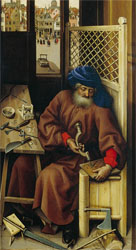 Title
Title"Mother and Child"
Origin
Byzantine (Constantinople)
Date
Circa 5th century
Classification
Originally used on war victory banners
Current location
Original icon was destroyed in the Fall of Constantinople
The Hodegetria image is particularly commonplace among the Eastern Orthodox, Oriental Orthodox, and Eastern Catholic Churches. Hodegetria (Gr., Οδηγήτρια) means "She who shows the Way". Mary, the Mother of Christ, is called Theotokos (Gr. Θεοτόκος), literally meaning "God-bearer" or "the one who gives birth to God". It was decreed by the Counsel of Ephesus in 431 that Theotokos should be identified with Mary, mother of the Christ. Traditionally, the Hodegetria refers to the icon at Hodegon Monastery in Constanople, but thereafter all images of Mother and Child with the characteristics addressed in the following are referred to as Hodegetria. The original Hodegetria icon was installed by the Empress Pulcheria in the mid-fifth century in Hodegon Monastery, eastern Constantinople. The icon itself was used long before it acquired its title as Hodegetria. Tradition accredits the icon to St. Luke, the evangelist.
Any image of Hodegetria will engage Mary with the viewer in a frontal gaze. Mary points to the Christ Child held on the viewer's left side, but on her right side (the side of Christ may vary according to origin). This is significant to the duality of Mary, who immaculately delivered the Saviour of humanity unto the world and served as the human bride of God. The Christ Child is identified as the path to Salvation by Mary, who points to Him with her manneristically elongated fingers. The receptive demeanor of the Christ Child expresses His acknowledgment of His fate as the Saviour of all of humanity. He holds His right hand up in blessing, holding the index and middle fingers together, which also refers to Christ's dual nature as divine and human. Furthermore, the thumb locked over the other fingers signify the Trinity. A starburst is on one or both shoulders and on the part of the mantle that covers the forehead. Logograms on the left and right, level with the top of the Virgin's head, appear to be "Θς", the first and last initials of the Greek word Θεοτόκος, or "God-bearer". The fringe on the mantle indicates Mary's imperial status, as does the throne that is occasionally included in the image. The image below exhibits how wide-spread the image was before the Great Schism of the 15th century. Additionally, it shows Hodegetria iconography variability, featuring Madonna and Child enthroned. In Hodegetria images with angels, the four archangels are iconographically represented: Gabriel, Michael, Raphael, and Uriel.
 Title
Title"Madonna and Child with Angels", Book of Kells (fol. 7v)
Origin
Insular (Anglo-Saxon)
Date
8th Century
Medium
Vellum
Dimensions
13"x9 1/2"
Classication
Full-page miniature
Current location
Dublin, Ireland
Acquired in 1654
MS 58


